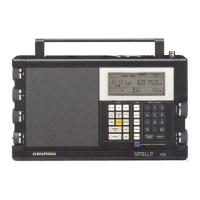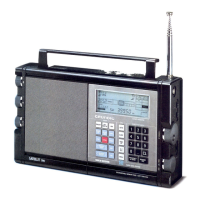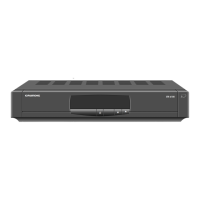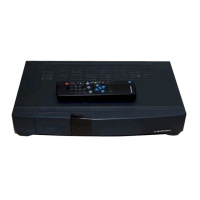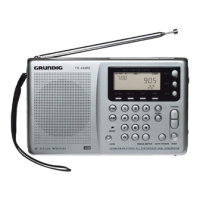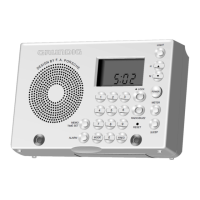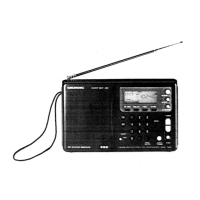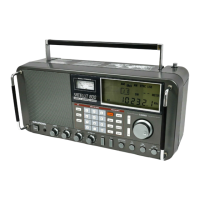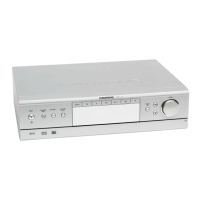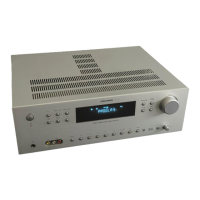Do you have a question about the Grundig SATELLIT500 and is the answer not in the manual?
Explains indicators for automatic, time, sleep, mono/stereo, LSB/USB, frequency, waveband, and signal.
Details memory positions, station names, tuning status, and bandwidth.
Covers telescopic aerial and audio output sockets.
Describes volume, tone, locking switch, and mode buttons.
Explains USB, SEARCH, and LSB functions for tuning and selection.
Details the TIMER buttons for clock and sleep functions.
Covers direct key input for frequencies, meter bands, and memory recall.
Details tuning knob, AGC/MGC, aerial switch, and DX/LOC settings.
Explains coaxial sockets, external aerial connection, and battery compartment features.
Details battery types and their installation for operation.
Covers charging times, low voltage, data protection, and environmental notes.
How to check battery status via BATT. CHECK indicator.
Connecting to mains unit NR90 or 9-12V DC external sources.
Using telescopic, ferrite rod, and external aerials for reception.
Covers switching on/off and direct numeric entries for functions.
How display illumination works on external power or battery.
Manual tuning, waveband selection, and frequency indication.
Entering frequencies directly using numeric buttons.
Provides examples for entering frequencies on FM and AM.
Entering numbers interpreted as wavelengths in meters for SW.
How the display shows meter bands or "HA" status.
Using the SEARCH button for FM stations.
Automatic comparison with stored memory stations.
Scanning AM bands in raster steps using SEARCH.
Scanning SW meter bands and frequency steps.
Lists receivable SW bands and their frequencies.
Storing up to 42 stations with modes and abbreviations.
Verifying stored stations and choosing memory slots.
Accessing stations via memory buttons.
Using the FREE button to find empty slots.
Process of saving stations into memory slots.
Accessing stored stations and removing them from memory.
Adding up to 4-character abbreviations for stations.
Using the tuning knob and buttons for name input.
Changing bandwidth for better separation or sound quality.
Using synchronous detector to minimize interference.
Fine-tuning input circuit selectivity.
Setting a playing time up to 60 minutes.
Viewing remaining sleep time or switching the unit off.
Programming the current time and a second timezone.
Showing the current time in main or small display.
Setting two independent switch-on and switch-off times.
Linking programmed times to local or second timezone.
Programming the first switch-on and switch-off time.
Linking a specific station to a programmed switch-on time.
Exiting programming mode after setting times.
Enabling programmed switch-on/off times using AUTO.
Checking programmed switch-on, station, and switch-off times.
Removing programmed switch-on times using CL.
Enabling/disabling automatic functions via AUTO button.
Connecting a cassette recorder to record timed programmes.
Starting/stopping recordings with logic-controlled recorders.
Scanning SW bands and using tuning indicator for speech.
Choosing the correct side band for intelligible speech.
Adjusting AGC/MGC and SENS DX/LOC for best reception.
Switching from SSB back to normal AM reception.
Using a soft cloth for cleaning the cabinet.
Compliance with safety standards and regulations.
Details power supply, wavebands, frequencies, and output.
Explains indicators for automatic, time, sleep, mono/stereo, LSB/USB, frequency, waveband, and signal.
Details memory positions, station names, tuning status, and bandwidth.
Covers telescopic aerial and audio output sockets.
Describes volume, tone, locking switch, and mode buttons.
Explains USB, SEARCH, and LSB functions for tuning and selection.
Details the TIMER buttons for clock and sleep functions.
Covers direct key input for frequencies, meter bands, and memory recall.
Details tuning knob, AGC/MGC, aerial switch, and DX/LOC settings.
Explains coaxial sockets, external aerial connection, and battery compartment features.
Details battery types and their installation for operation.
Covers charging times, low voltage, data protection, and environmental notes.
How to check battery status via BATT. CHECK indicator.
Connecting to mains unit NR90 or 9-12V DC external sources.
Using telescopic, ferrite rod, and external aerials for reception.
Covers switching on/off and direct numeric entries for functions.
How display illumination works on external power or battery.
Manual tuning, waveband selection, and frequency indication.
Entering frequencies directly using numeric buttons.
Provides examples for entering frequencies on FM and AM.
Entering numbers interpreted as wavelengths in meters for SW.
How the display shows meter bands or "HA" status.
Using the SEARCH button for FM stations.
Automatic comparison with stored memory stations.
Scanning AM bands in raster steps using SEARCH.
Scanning SW meter bands and frequency steps.
Lists receivable SW bands and their frequencies.
Storing up to 42 stations with modes and abbreviations.
Verifying stored stations and choosing memory slots.
Accessing stations via memory buttons.
Using the FREE button to find empty slots.
Process of saving stations into memory slots.
Accessing stored stations and removing them from memory.
Adding up to 4-character abbreviations for stations.
Using the tuning knob and buttons for name input.
Changing bandwidth for better separation or sound quality.
Using synchronous detector to minimize interference.
Fine-tuning input circuit selectivity.
Setting a playing time up to 60 minutes.
Viewing remaining sleep time or switching the unit off.
Programming the current time and a second timezone.
Showing the current time in main or small display.
Setting two independent switch-on and switch-off times.
Linking programmed times to local or second timezone.
Programming the first switch-on and switch-off time.
Linking a specific station to a programmed switch-on time.
Exiting programming mode after setting times.
Enabling programmed switch-on/off times using AUTO.
Checking programmed switch-on, station, and switch-off times.
Removing programmed switch-on times using CL.
Enabling/disabling automatic functions via AUTO button.
Connecting a cassette recorder to record timed programmes.
Starting/stopping recordings with logic-controlled recorders.
Scanning SW bands and using tuning indicator for speech.
Choosing the correct side band for intelligible speech.
Adjusting AGC/MGC and SENS DX/LOC for best reception.
Switching from SSB back to normal AM reception.
Using a soft cloth for cleaning the cabinet.
Compliance with safety standards and regulations.
Details power supply, wavebands, frequencies, and output.
| Type | Portable Receiver |
|---|---|
| Display | LCD |
| Battery Operation | 6 x D cells |
| Memories | 42 |
| Bands | LW, MW, SW, FM |
| Tuning System | PLL Synthesizer |
| Frequency Range | FM: 87.5-108 MHz |
| Modes | AM, FM |
| Antenna | Telescopic antenna (FM/SW), External antenna jack |
| Output | Headphone Jack |
| Additional Features | Clock, Timer |
| Tuning Steps | 1 kHz |
| Speakers | Built-in |
| Memory Presets | 42 (7 per band) |
